Draft Decision on the Leased Lines Reference Offer
I. Framework
The Decision on the assessment of wholesale terminating and wholesale trunk segments of leased lines imposed upon the PT Group, among other obligations, the obligation to submit to ICP-ANACOM, within a 30-working-day deadline, an analogue and digital leased lines reference offer (LLRO) up to 155 Mbps (inclusive) to wholesale customers, including:
(a) technical and performance characteristics of the various types of leased lines segments;
(b) prices, duly broken down by component;
(c) compulsory SLAs, including conditions on supply and migration, fault notification and repair, and respective penalties for non-compliance; and
(d) specific conditions related to routes, to Continent-Azores-Madeira (CAM) leased lines, to leased lines part circuits (and interconnection support components), to sub-sea cables access service and to the provision of symmetric xDSL technologies (where, and when, provided at retail level or to companies of the PT Group).
On 26.08.2005, PT Comunicações, S.A. (PTC) submitted a LLRO to this Authority, the prices of which were the same as the prices in force on that date, having ICP-ANACOM determined on 08.09.2005, in the light of the principle of cost-orientation:
1. to request from the PT Group the review, within a 20-day deadline, of the wholesale and retail prices of the leased lines service, taking into account the principle of cost-orientation of prices and the minimum difference between wholesale and retail prices, as defined in the leased lines market assessment;
2. that for this review the PT Group should consider the specific costs of the various components and capacities broken down in the tariffs of the leased lines service;
3. that the tariffs that complied with the above-mentioned principles would enter into force on 01.01.2006.
On 19.10.2005, PTC and PT Prime submitted to ICP-ANACOM a draft review of wholesale and retail prices of the leased lines service, respectively, to take effect as from 01.01.2006.
Within this context, the conditions established in the LLRO, as well as prices proposed by the PT Group to take effect as from 01.01.2006, are assessed below.
II. Assessment of the LLRO
The conditions put forward by PTC in the scope of the LLRO, which are deemed to be in need of a review, are presented below, whenever possible in the order they are presented within the offer.
1. General conditions
Section 1. Introduction (pg.3)
Provision
The offer refers that leased lines may be used by OSP, for:
- establishing and developing their electronic communications network;
- interconnecting public electronic communications networks;
- supporting the provision of other electronic communications retail services achieved downstream by their customers;
- renting leased lines to their end-customers.
Assessment and position of ICP-ANACOM
It is noted that the examples put forward by PTC do not refer the possibility of OSP using lines leased by PTC in order to rent them to other operators and service providers (that is, at a wholesale market level).
ICP-ANACOM deems that the LLRO should not restrict OSP from using lines rented by PTC as they deem best. That is, as a general rule, OSP should be able to request a line from PTC, whatever their intended purpose may be, PTC not being entitled to refuse its supply, provided the request is reasonable.
In the light of the above, the provision above must be withdrawn from the offer or be clarified in the sense that, in addition to those types of usage, OSP may use the LLRO to provide leased lines services to other OSP.
Section 1. Terms and definitions (pg.5)
Provision
PTC refers a set of dates, including:
- date of request: working day on which PTC receives the formal request from the OSP;
- date of technical readiness: day on which the line is installed and is deemed ready to become operational, that is, is ready to be used by the OSP;
- target date: day on which the OSP intends the line to be available.
Assessment and position of ICP-ANACOM
ICP-ANACOM does not oppose to the conclusion of an agreement between PTC and the OSP concerning a target date for the supply of lines requested by the OSP, in case the latter promotes a better planning and resource management. Without prejudice, it is considered that:
(a) the target date must not limit the time limits for line installation provided for in the offer, and thus, the target date must not exceed the supply time for network line installation;
(b) the installation time limits must of course be calculated from the date of request and not as from the target date, this being, in any event, the interpretation that results from the offer.
Section 3. Services comprised and respective characteristics (pg.7)
Provision
Where services comprised in the LLRO are specified, the following are referred, among others: “lines for traffic interconnection between PTC and the OSP, including interconnection lines and internal extensions for interconnection”.
Assessment and position of ICP-ANACOM
Without prejudice to the remaining pages of the offer 1, this paragraph seems to indicate that the lines for traffic interconnection, interconnection lines and internal extensions for interconnection may only be used to perform the interconnection between the OSP requesting the line and PTC. Thus the possibility of an OSP using these services to supply a third operator, for instance, with the service of traffic interconnection with PTC, would be excluded. This view results in a failure to comply with the Determination of ICP-ANACOM dated 27.05.2004 2.
Thus, in line with the position presented in the previous point, the paragraph presented should be amended to clarify that an OSP may request internal extensions for interconnection to supply a third operator with the service of traffic interconnection with PTC.
Section 3.1. Leased lines - part circuits (pg.8)
Provision
It is referred that a part circuit "consists of a connection between a NTP 3 co-installed in an exchange of PT Comunicações and a NTP not co-installed in exchanges of PT Comunicações, the internal extension, ML 4 and LE 5 being supplied by PT Comunicações".
Assessment and position of ICP-ANACOM
It must be clarified that the supply of a part circuit does not imply the installation of a main line on the part of PTC.
Section 3.1. Leased lines - part circuits (pg. 8) (and other sections of the offer) and Appendix B - Telecommunications Terminal Equipment
Provision
The offer proposal presented by PTC refers that "the features of the coaxial distribution frame are subject to the prior approval of PT Comunicações…" and that any equipment installed by the OSP in its buildings should receive its agreement, no time limits being stated for this approval or agreement.
Assessment and position of ICP-ANACOM
It is considered that the wording put forward by PTC does not guarantee the necessary transparency nor doe it ensure non-discrimination in the scope of the approval of coaxial distribution frames or of the agreement with other equipment to be co-installed, being required, namely, that the features of equipment that PTC wishes to be installed must be reasonable and appropriate, and must be duly specified a priori in the offer. In case OSP wish to install equipment with different features from those provided in the offer, PTC must assess the possibility of installation of such equipment within a 10-working-day deadline, and in case of a negative reply must present adequate justification thereto.
Section 4. Service engagement (pg. 11)
Provision
The offer refers that "the provision of services comprised in the LLRO is subject to the conclusion of a contract in writing, the form of which shall be sent to the OSP, which must be concluded within a 30-day negotiation deadline, from the date the OSP receives the contractual form, save where the parties agree on a time extension." It is also provided that "having elapsed the referred 30-day time-limit, or the agreed extension, PT Comunicações is entitled to suspend the provision of services comprised in the LLRO", and parties are entitled to appeal to ICP-ANACOM.
Assessment and position of ICP-ANACOM
It is not deemed reasonable to impose a 30-day time limit calculated from the date the OSP receives the contractual form to conclude a contract in writing, PTC being entitled to suspend the provision of services comprised in the LLRO, in case an agreement is not reached between the parties. It should be noted that PTC thus maintains the negotiation power in its side, in view of the fact that, without prejudice to the possibility of an appeal to ICP-ANACOM, services provided to the OSP are to be suspended until a decision on the part of this Authority is issued.
Therefore, such a time-limit, which does not exist in the scope of other regulated offers, is not acceptable, and must thus be suppressed.
Section 9. Billing Procedures (pg. 13) and Annex 7: Section 1.1. Billing of new line (pg.1)
Provision
Billing procedures are described in Annex 7, however it is first stated that the billing shall be carried out at monthly intervals, "except for lines for sub-sea cables access, the billing of which is performed on an annual basis".
Assessment and position of ICP-ANACOM
It is not deemed reasonable to bill the lines for sub-sea cables access on an annual basis, and thus, like other lines, the lines concerned should be billed at a monthly frequency.
Section 10.4. Service interruption and suspension (pg.17)
Provision
The LLRO states that, among other reasons, "the need to carry out control operations, adjustments or routine maintenance procedures, aiming to ensure the smooth operation of its network", is considered grounds for the interruption or suspension of certain services provided for in the offer.
Assessment and position of ICP-ANACOM
Notwithstanding the fact that the LLRO mentions that the referred operations shall be notified by PTC to OSP in good time, it is considered that these operations should be carried out, whenever possible, on a date previously agreed between PT Comunicações and the OSP, in line with the procedure established for the RIO.
Whenever possible, PTC must also guarantee alternatives, namely temporary security procedures, which enable a minimum service interruption.
Annex 1: Section 1.3, 2.3 and 3.3 Installation/Alteration of a line (pgs. 6, 9, 14 and 19)
Provision
PTC refers that the "when submitting each request, the OSP must indicate the target date which, save where PTC agrees to the contrary, must be at the earliest:
- 90 days, calculated from the date of request, in case of lines that connect to a new OSP knot or the supply of which implies the installation of fibre optic in the local extension;
- 30 days, calculated from the date of request, in other cases."
Assessment and position of ICP-ANACOM
ICP-ANACOM deems it excessive to set a target date of 90 days at the earliest, calculated from the date of request, in case of lines that connect to a new OSP knot or the supply of which implies the installation of fibre optic in the local extension, when in other cases the minimum time limit is of 30 days.
To this effect, PTC must reduce the referred minimum time-limit from 90 to 30 days.
Annex 1: Section 1.3, 2.3 Installation of a line (pgs. 6 and 14) and Annex 5: Section 1.1 and 1.4 (pgs. 5 and 7)
Provision
It is referred that the target date for a 155 Mbps line "shall be agreed on a case-by-case basis between PT Comunicações and the OSP".
Assessment and position of ICP-ANACOM
In this regard, the referred principle that the target date must not exceed the supply time for network line installation must be complied with.
Annex 1: Section 1.3, 2.3 and 3.3 Installation of a line (pgs. 7, 14 and 19)
Provision
The offer establishes that "in case the line installation is in a pending situation on account of the customer for a 30-day period, consecutive or not, following the elapse of the target date, PT Comunicações shall presume the abandonment of the application on the part of the OSP and shall accordingly cancel the line request, reserving the right to claim a compensation of an amount which represents twice the value of the line’s monthly subscription price, plus the price of installation thereof."
Assessment and position of ICP-ANACOM
In the view of ICP-ANACOM, it is more reasonable that, where a pending situation occurs on account of the customer for a 30-day period, consecutive or not, following the elapse of the target date, the billing should start on the target date. As a result, PTC is remunerated for the service provided, and at the same time, the OSP is duly encouraged to carry out the work incumbent thereon to ensure the proper functioning of the service as soon as possible.
In this context, the offer must be adjusted having regard to the view above-stated.
Annex 1: Section 1.3, 2.3 and 3.3 Cancellation of a request for line installation (pgs. 7, 14 and 20)
Provision
In case the OSP cancels the installation of a line in a pending situation on account of the customer for a 30-day period, consecutive or not, following the elapse of the target date, PT Comunicações shall reserve the right to "claim a compensation of an amount which represents twice the value of the line’s monthly subscription price, plus the price of installation thereof."
Assessment and position of ICP-ANACOM
It is considered that in this case the view taken in the preceding point should also be adopted. That is, where the installation cancellation occurs in the scope of lines in a pending situation on account of customers for a 30-day period, consecutive or not, following the elapse of the target date, is appears to be more reasonable that the billing should start on the target date, the OSP being liable to a payment that corresponds to the period between the target date and the disconnection date.
Annex 1: Section 1.4 Security means (pg.10)
Provision
It is referred in this section that "in the scope of the negotiation of special supply conditions, where so requested by the OSP and as far as it is technically possible, specific security means at the level of the respective LEs may be introduced (…) the technical and business conditions of which shall be assessed on a case by case basis".
Assessment and position of ICP-ANACOM
It is important to ensure that, while enabling the negotiation of situations of supply that ensure that operators enjoy an increased adequacy and flexibility in the supply of certain lines, the "special supply conditions" are not discriminatory.
Thus it is considered that the offer should clarify that the technical and commercial conditions applied in a "special situation" must be the same as those applied in any other similar situation, in case the customer so wishes. It must be also made clear that, even where situations are not similar, the technical and business conditions shall be proportional and coherent in relation to all cases of supply.
Annex 1: Section 1.5 Minimum retention time (pg.11)
Provision
PTC proposes a minimum retention time of 6 months (without security) or of 12 months (with security) as regards lines with 155 Mbps capacity.
Assessment and position of ICP-ANACOM
One of the reasons invoked by PTC for maintaining the fidelity reward is the increased guarantee involved in the recovery of costs made with the line supply, as according to PTC, the leased lines service does not involve "any contractual deadline established a priori", which seems reasonable.
However, the application of a "penalty" in case the OSP does not intend to lease the line for the minimum time-limit imposed by PTC (in this case, 6 months without security or 12 months with security), as far as lines with 155 Mbps capacity are concerned, does not appear to be reasonable.
To this effect, that condition must be suppressed.
Annex 1: Section 3.5 Retention time (pg.21)
Provision
As regards lines for sub-sea cables access, the offer provides for a lease for a minimum contractual time limit of 1 year, and the notice of termination thereof must be submitted at least two months ahead of that date – otherwise the contract is automatically renewed.
Assessment and position of ICP-ANACOM
In line with the previously stated view, it is not deemed reasonable to define minimum time-limits to the leased lines service, thus such time limits must be suppressed from the offer.
Annex 5: Section 1.4 Lines for sub-sea cables access (pg.8)
Provision
The offer provides that "in case the OSP is not the owner of the capacity of the sub-sea system it wishes to interconnect with, PT Comunicações shall be sent documentary evidence (LOA) that the capacity owner authorizes the connection thereof with the backhaul requested by the OSP".
Assessment and position of ICP-ANACOM
PTC shall provide ICP-ANACOM with information on the need for the referred documentary evidence (LOA), and in case grounds thereon are not deemed reasonable, the requirement of the need for such documentary evidence to be sent by the OSP to PTC, in case the former is not the owner of the capacity of the sub-sea system it wishes to interconnect with, must be suppressed.
Annex 5: Section 2.1 Pending situation on account of PT Comunicações (pg.8)
Provision
The offer refers that "a pending request on account of PT Comunicações occurs where the line installation, alteration and/or repair procedure has been suspended for reasons imputable to the OSP".
Assessment and position of ICP-ANACOM
The sentence has been mistakenly written and should be amended to "a pending request on account of PT Comunicações occurs where the line installation, alteration and/or repair procedure has been suspended for reasons imputable to PT Comunicações", as the pending situation on account of PTC occurs for reasons imputable to this company, and not to the OSP.
Annex 6: Section 3 Monitoring and control (pg.5)
Provision
According to the LLRO, "where justified and by agreement between PT Comunicações and the OSP, the parties shall hold operational control meetings". It is also mentioned that "these meetings aim to debate pending situations on account of customers and situations of operational constraints which prevent the fulfilment of prior agreements on dates".
Assessment and position of ICP-ANACOM
It is important that operational control meetings aim also to debate pending situations on account of PTC. Thus, the offer must be accordingly amended.
Annex 6: Section 3 Monitoring and control (pg.5)
Provision
The offer provides that, three days ahead of the scheduled date, the OSP must submit to PTC a list of all pending requests, highlighting the ones the fulfilment dates of which are deemed critical.
Assessment and position of ICP-ANACOM
It is deemed important that, on account of the view stated in the preceding point, PTC likewise submits to the OSP with the referred advance a list of pending situations, describing causes thereto and the period of time deemed necessary to restore such situations.
Annex 6: Section 5.1 Fault reporting (pg.5)
Provision
The offer refers that "it is incumbent upon the OSP to contact PT Comunicações in order to deal with identified problems as soon as possible".
Assessment and position of ICP-ANACOM
Without prejudice to this provision, it is important also to state that, in case PTC identifies a fault, it should also launch all procedures necessary to restore the situation, proactively reporting the fault to the OSP.
Annex 6: Section 5.2 Fault repair procedure (pg.6)
Provision
The offer mentions that "where the fault occurs in the premises of the end-customer of the OSP, PTC reserves the right to contact him/her directly in case access to such premises is necessary to repair the fault".
Assessment and position of ICP-ANACOM
It is questionable that the OSP is not involved in this procedure, thus any contacts made to the end-customer, in case access to his/her premises is necessary to repair the fault, must be established by the OSP itself, and for this purpose, PTC shall undertake to make all necessary approaches to the OSP.
2. Prices
2.1. Proposal submitted by PTC
According to PTC, the main issues of the draft review are as follows:
(a) Inclusion in basic prices of the billing discount, which amounted to 26%, in base prices;
(b) Alteration of the price structure applicable to leased lines, in order to ensure coherent prices of the different components (fixed and floating components) for the various speeds, guaranteeing economic continuity in the different classes of length, namely:
- in analogue lines, the price structure of which has been simplified, and rendered in line with that of digital lines, with a fixed price per local extension, the main line comprising a fixed component and a floating component, depending on the distance in a straight line between the terminal local exchanges;
- in digital lines at N×64 Kbps, in the scope of which there were some irregularities of prices of main line fixed components of the class below 10 km compared with 2 Mbps digital lines, which were duly amended;
- in high-speed digital lines, where amendments have been introduced to the price ratio between prices of 34 Mbps and 2 Mbps lines, to a value of 6,3, in order supposedly to bring it in line with the European average, and between prices of 155 Mbps and 34 Mbps lines, also as regards the local extension, to a value of 2,2.
(c) Additional reduction of line prices, particularly in the CAM sections, PTC putting forward, per each rate, prices closer to those of lines located in the Continent with a main section of 550 km 6.
PTC's price proposal is below identified in detail.
2.1.1. Installation
PTC proposes to maintain installation prices for digital lines and to apply a single installation price of €85,00 per local extension for analogue lines, irrespective of the number of wires (2, 4 or 6 wires) or the quality (M.1020, M.1025 e M.1040). According to PTC, the establishment of a single price for analogue line installation aims, on the one hand, to simplify its applications, and, on the other, to reduce the deficit that characterizes analogue lines.
It should be noted that at present the installation price of analogue lines is €44,89 per local extension for local lines without occupation of joinings and of €89,78 per local extension for national lines.
2.1.2. Monthly payment
End-to-end analogue lines
PTC proposes to cut down gross and net prices of analogue lines. According to PTC, prices put forward are higher that the current ones only in the situation of local analogue lines, that is, without a main line between exchanges - in this case the current maximum price corresponds to 1,5 km per local extension, thus the application of a structure identical to digital lines, with a fixed price per local extension, may lead to a maximum increase by 5% compared to current net prices.
Also in regard of monthly prices applicable to analogue lines, PTC proposes to define an additional price, per local extension, of €12,60 and of €25,60, when switching from normal quality (M.1040) to the M.1020 and M.1025 special qualities, respectively, for 2 wire analogue lines.
Monthly prices proposed by PTC for end-to-end analogue lines are presented below:
|
Type of analogue line |
Monthly payment |
||||
|
Per LE |
Main Line |
||||
|
< 10 Km |
Between 10 and 30 Km |
||||
|
Fixed |
Floating |
Fixed |
Floating |
||
|
2F / W.1040 |
12,40 |
17,00 |
4,60 |
41,00 |
2,20 |
|
2F / W.1025 |
25,00 |
17,00 |
4,60 |
41,00 |
2,20 |
|
2F / W.1020 |
38,00 |
17,00 |
4,60 |
41,00 |
2,20 |
|
4F / W.1040 |
18,60 |
25,50 |
6,90 |
61,50 |
3,30 |
|
4F / W.1025 |
37,50 |
25,50 |
6,90 |
61,50 |
3,30 |
|
4F / W.1020 |
57,00 |
25,50 |
6,90 |
61,50 |
3,30 |
|
6F / W.1040 |
31,00 |
42,50 |
11,50 |
102,50 |
5,50 |
|
6F / W.1025 |
62,50 |
42,50 |
11,50 |
102,50 |
5,50 |
|
6F / W.1020 |
95,00 |
42,50 |
11,50 |
102,50 |
5,50 |
|
Type of analogue line |
Monthly payment |
|||
|
Main Line |
||||
|
Between 30 and 50 Km |
Between 50 and 100 Km |
|||
|
Fixed |
Floating |
Fixed |
Floating |
|
|
2F / W.1040 |
62,00 |
1,50 |
97,00 |
0,80 |
|
2F / W.1025 |
62,00 |
1,50 |
97,00 |
0,80 |
|
2F / W.1020 |
62,00 |
1,50 |
97,00 |
0,80 |
|
4F / W.1040 |
93,00 |
2,25 |
145,50 |
1,20 |
|
4F / W.1025 |
93,00 |
2,25 |
145,50 |
1,20 |
|
4F / W.1020 |
93,00 |
2,25 |
145,50 |
1,20 |
|
6F / W.1040 |
155,00 |
3,75 |
242,50 |
2,00 |
|
6F / W.1025 |
155,00 |
3,75 |
242,50 |
2,00 |
|
6F / W.1020 |
155,00 |
3,75 |
242,50 |
2,00 |
|
Type of analogue line |
Monthly payment |
||
|
Main Line |
CAM sections |
||
|
> 100 Km |
|||
|
Fixed |
Floating |
||
|
2F / W.1040 |
137,00 |
0,40 |
360,00 |
|
2F / W.1025 |
137,00 |
0,40 |
360,00 |
|
2F / W.1020 |
137,00 |
0,40 |
360,00 |
|
4F / W.1040 |
205,50 |
0,60 |
540,00 |
|
4F / W.1025 |
205,50 |
0,60 |
540,00 |
|
4F / W.1020 |
205,50 |
0,60 |
540,00 |
|
6F / W.1040 |
342,50 |
1,00 |
900,00 |
|
6F / W.1025 |
342,50 |
1,00 |
900,00 |
|
6F / W.1020 |
342,50 |
1,00 |
900,00 |
Prices in Euros
End-to-end digital lines, half-circuit component of part circuits, interconnection lines and national backhaul component
PTC proposes to cut down gross prices of digital lines for all speeds and length classes, in view of the following:
(a) the gross price of local extensions is reduced between 19,5% (64 Kbps) and 37,5% (34 Mbps), except for 155 Mbps lines, the price of which is increased by 15% or reduced by 71%, depending on whether one considers the minimum value for local extensions without security or the maximum value for local extensions with security, respectively;
(b) the gross price of main lines is cut down for all speeds and length classes, ranging from 20% (for the floating component of 4 Kbps lines above 50 km) to 40% (for the fixed component of 1536 Kbps lines below 10 km);
(c) the gross price of CAM sections is reduced between 27% (192 Kbps) and 60% (34 and 155 Mbps).
Monthly prices proposed by PTC for these lines are presented below:
|
Speeds |
Monthly payment |
||||
|
Per local |
Main Line |
||||
|
< 10 Km |
Between 10 and 30 Km |
||||
|
Fixed |
Floating |
Fixed |
Floating |
||
|
64 Kbps |
35,00 |
25,00 |
4,50 |
49,00 |
2,20 |
|
128 Kbps |
50,00 |
50,00 |
7,70 |
75,00 |
5,20 |
|
192 Kbps |
58,00 |
65,00 |
10,00 |
97,00 |
6,80 |
|
256 Kbps |
70,00 |
75,00 |
12,20 |
112,00 |
8,50 |
|
384 Kbps |
73,00 |
80,00 |
14,50 |
123,00 |
10,20 |
|
512 Kbps |
80,00 |
85,00 |
16,70 |
134,00 |
11,80 |
|
768 Kbps |
85,00 |
87,00 |
17,90 |
139,00 |
12,70 |
|
1024 Kbps |
90,00 |
90,00 |
19,00 |
145,00 |
13,50 |
|
1536 Kbps |
95,00 |
92,00 |
20,10 |
150,00 |
14,30 |
|
2 Mbps |
100,00 |
94,00 |
23,65 |
180,00 |
15,05 |
|
34 Mbps |
630,00 |
592,20 |
149,00 |
1.134,00 |
94,82 |
|
155 Mbps |
1.386,00 |
1.302,84 |
327,79 |
2.494,80 |
208,59 |
|
Speeds |
Monthly payment |
|||
|
Main Line |
||||
|
Between 30 and 50 Km |
Between 50 and 100 Km |
|||
|
Fixed |
Floating |
Fixed |
Floating |
|
|
64 Kbps |
70,00 |
1,50 |
105,00 |
0,80 |
|
128 Kbps |
120,00 |
3,70 |
190,00 |
2,30 |
|
192 Kbps |
151,00 |
5,00 |
246,00 |
3,10 |
|
256 Kbps |
178,00 |
6,30 |
288,00 |
4,10 |
|
384 Kbps |
201,00 |
7,60 |
336,00 |
4,90 |
|
512 Kbps |
224,00 |
8,80 |
374,00 |
5,80 |
|
768 Kbps |
238,00 |
9,40 |
393,00 |
6,30 |
|
1024 Kbps |
247,00 |
10,10 |
417,00 |
6,70 |
|
1536 Kbps |
258,00 |
10,70 |
438,00 |
7,10 |
|
2 Mbps |
291,00 |
11,35 |
481,00 |
7,55 |
|
34 Mbps |
1.833,30 |
71,51 |
3.030,30 |
47,57 |
|
155 Mbps |
4.033,26 |
157,31 |
6.666,66 |
104,64 |
|
Speeds |
Monthly payment |
||||
|
Main Line |
CAM sections |
||||
|
> 100 Km |
Routes* |
||||
|
Fixed |
Floating |
Fixed |
Floating |
||
|
64 Kbps |
145,00 |
0,40 |
|
|
400,00 |
|
128 Kbps |
310,00 |
1,10 |
|
|
950,00 |
|
192 Kbps |
396,00 |
1,60 |
|
|
1.300,00 |
|
256 Kbps |
498,00 |
2,00 |
|
|
1.600,00 |
|
384 Kbps |
576,00 |
2,50 |
|
|
2.000,00 |
|
512 Kbps |
664,00 |
2,90 |
|
|
2.300,00 |
|
768 Kbps |
713,00 |
3,10 |
|
|
2.450,00 |
|
1024 Kbps |
757,00 |
3,30 |
|
|
2.600,00 |
|
1536 Kbps |
788,00 |
3,60 |
|
|
2.800,00 |
|
2 Mbps |
861,00 |
3,75 |
688,80 |
3,00 |
2.950,00 |
|
34 Mbps |
5.424,30 |
23,63 |
4.339,44 |
18,90 |
18.585,00 |
|
155 Mbps |
11.933,46 |
51,98 |
9.546,77 |
41,58 |
40.890,00 |
Prices in Euros
* Routes: Lisbon-Oporto, Lisbon-Coimbra and Lisbon-Faro
According to the proposal submitted by PTC, the change in net revenue of the proposed tariff compared to the current tariff is as follows:
|
Speeds |
Monthly payment |
||||
|
Local |
Main Line |
||||
|
<10Km |
10<Km<30 |
30<Km<50 |
50<Km<100 | ||
|
64K |
8.1% |
2.1% |
1.8% |
0.9% |
-0.4% |
|
128K |
-0.2% |
-2.5% |
-0.6% |
0.1% |
-3.6% |
|
192K |
-4.7% |
2.9% |
2.6% |
2.2% |
2.2% |
|
256K |
-0.9% |
-0.5% |
0.1% |
-0.1% |
-0.7% |
|
384K |
-1.8% |
-3.0% |
0.2% |
0.9% |
1.5% |
|
512K |
-4.9% |
-9.6% |
-5.2% |
-3.9% |
-5.5% |
|
768K |
-2.8% |
-8.7% |
-4.1% |
-0.2% |
-15.0% |
|
1024K |
-3.3% |
-11.6% |
-5.6% |
-1.9% |
-3.1% |
|
1536K |
-2.0% |
-12.8% |
-8.5% |
-0.7% |
0.0% |
|
2M |
-2.0% |
-3.1% |
-1.1% |
0.4% |
0.5% |
|
34M |
-16.7% |
-19.1% |
-22.1% |
-14.6% |
-14.5% |
|
STM1 |
-27.9% |
-14.6% |
-14.7% |
-14.6% |
-14.5% |
|
TOTAL |
-4.5% |
-4.3% |
-2.5% |
-4.4% |
-9.2% |
|
Speeds |
Monthly payment |
TOTAL |
||
|
Main Line |
CAM |
|||
|
>100Km |
Routes |
|||
|
64K |
-0.4% |
0.0% |
-16.6% |
5.2% |
|
128K |
-6.0% |
0.0% |
-8.1% |
-1.1% |
|
192K |
-0.5% |
0.0% |
0.0% |
-1.6% |
|
256K |
-3.8% |
0.0% |
-17.3% |
-1.1% |
|
384K |
-4.4% |
0.0% |
-17.1% |
-1.2% |
|
512K |
-1.7% |
0.0% |
-21.3% |
-5.8% |
|
768K |
-2.9% |
0.0% |
0.0% |
-4.2% |
|
1024K |
-4.7% |
0.0% |
-37.1% |
-6.6% |
|
1536K |
1.2% |
0.0% |
-35.4% |
-7.8% |
|
2M |
-4.7% |
-3.4% |
-35.3% |
-3.3% |
|
34M |
0.0% |
0.0% |
-44.3% |
-19.8% |
|
STM1 |
-14.5% |
-14.6% |
-44.7% |
-21.6% |
|
TOTAL |
-7.8% |
-8.1% |
-38.8% |
-6.2% |
2.1.3. Discount regime
PTC proposes the withdrawal of the billing discount, including it in base prices, and the maintenance of the fidelity reward, which is a discount to be granted on a monthly basis to each line as from a year from the respective date from which fees are charged, with a variation of the discount percentage according to the respective year of fidelity of the line installed.
In the view of PTC, as the leased line service does not entail any contractual time limit established a priori, the longer the period of fidelity of an installed line, the stronger will be the guarantee that their supply costs will be recovered. These gains justify, in the view of PTC, an increasing discount according to the period of line fidelity.
The proposal states that the fidelity reward applies for as long as the line is installed and insofar as the line does not undergo any alterations, except for speed increases and internal changes, according to the following table:
|
Year of Fidelity |
Discount % |
|
2.º year |
2% |
|
3.º year |
4% |
|
4.º year |
6% |
|
5.º year |
8% |
|
6.º year onwards |
10% |
This reward is granted to all end-to-end lines, to the half-circuit component of part circuits, to interconnection lines and the national backhaul component.
2.1.4. Margins
According to PTC, and having regard to the results of the global expense model for 2004 based on capital cost calculated on the basis of the book value which, for reasons already put forward 7, is the method ICP-ANACOM takes into account for price-definition purposes, all costs being considered, namely common costs, in the range of [start of confidential information (hereinafter SCI)] [end of confidential information (hereinafter ECI], the proposal entails a reduction:
- of leased lines global net gain from [SCI] [ECI] to [SCI] [ECI];
- of digital lines global net gain from [SCI] [ECI] to [SCI] [ECI];
- of analogue lines global net loss from [SCI] [ECI] to [SCI] [ECI].
PTC highlights the case of 34 Mbps lines, the proposal for which entails a reduction by 20% in revenues, with the associated negative effect in net gains, which alter from [SCI] [ECI] to [SCI] [ECI]. According to PTC, the loss that supposedly characterizes 34 Mbps lines is due to the limited demand of these lines. PTC expects that the price reduction leads to a more attractive offer and to an encouragement towards the engagement of this type of lines. In this case, PTC expects an increase of line installations and the resulting improvement of net gains in the medium term.
As far as analogue lines are concerned, according to PTC the proposal involves an increase by 2% of revenues, which entails the reduction of the associated loss. PTC refers that these lines are currently being replaced by 64 Kbps or N×64 Kbps digital lines, thus a reduction of prices in analogue lines would not affect the respective demand (it would rather make worse PTC’s loss).
PTC informs that, relatively to 155 Mbps lines, only those which were installed after 08.03.2004 were considered, as they are not comprised by multiannual contracts: PTC refers that 155 Mbps lines installed before that date, in the scope of the referred multiannual contracts in force at the time, were not included in the assessment due to their specific business conditions.
Also as regards the margin issue, it should be referred that, in the meanwhile, the cost accounting system data for the 1st half of 2005 was submitted, presenting a current margin of around [SCI] [ECI], for the global leased lines business, or of [SCI] [ECI], in case analogue lines are not considered.
This means the margins estimated by PTC are outdated, a matter which is analysed in section 2.3 Assessment of the principle of cost-orientation of prices proposed by PTC.
2.1.5. International comparisons
According to PTC, the prices now proposed, when compared to prices practised by other operators in the scope of the European Union (EU15) are among the best prices (as in the following table prepared by PTC):
|
64 Kbps |
2 Mbps |
34 Mbps |
155 Mbps |
||||||||
|
3Km |
50Km |
175Km |
3Km |
50Km |
175Km |
3Km |
50Km |
175Km |
3Km |
50Km |
175Km |
|
2nd |
1st |
2nd |
3rd |
2nd |
3rd |
4th |
3rd |
5th |
3rd |
3rd |
3rd |
In the analysis presented in section 2.4 Adjustment of prices to costs, it is concluded that these values, presented by PTC, seem to refer to comparisons at retail price level, and are not as correct as far as the comparison of gross prices is concerned. For example, in the analysis presented in section 2.4 Adjustment of prices to costs, it is concluded that Portugal is the 11th country with the highest gross prices for 155 Mbps lines at 50 km.
2.2. Evolution of line installation
It has been verified that the level of installation of digital leased lines has remained constant over the years, since 2001, the level of installation of analogue lines having presented a sustained reduction (by about 21% between 2001 and the 3rd quarter of 2005). Figure 1 shows this evolution, broken down by type of line.
Figure 1. Evolution of the level of installation of digital leased lines
between 2001 and the 3rd quarter of 2005
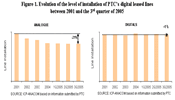
(Click here to see the full-size image)
Also as regards digital lines, large capacity lines (155 Mbps and above) have shown an increasing trend and 2 Mbps lines have maintained their level of installation, following an initial reduction, as Figure 2 illustrates.
Figure 2. Evolution of the level of installation of PTC's leased lines
between 2001and the 3rd quarter of 2005
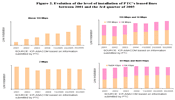
(Click here to see the full-size image)
2.3 Assessment of the principle of cost-orientation of prices proposed by PTC
According to PTC, the change in net revenue of tariffs proposed by PTC, according to current prices, would be of -6,2%, which results, as PTC itself refers, in a reduction of the net global margin for the leased lines service business from [SCI] [ECI] to [SCI] [ECI], and, in the particular case of digital lines, from [SCI] [ECI] to [SCI] [ECI]. It should be noted that in these calculations PTC took into consideration the results of the global expense model for 2004 and the line installation level in June 2005.
As referred above, having regard to the most recent data on costs, received on 30.12.2005, concerning the 1st half of 2005, the net global margin for the leased lines service business, was of [SCI] [ECI] and not [SCI] [ECI], and in the particular case of digital lines, was [SCI] [ECI] and not [SCI] [ECI]. Thus the proposal submitted by PTC, having regard to the most recent data, would result in significantly higher margins than those estimated based on the cost data for 2004, of around [SCI] [ECI] and [SCI] [ECI], respectively for the global line business and for digital lines.
These margins take into account the common costs in full, which represent [SCI] [ECI] of total costs, including curtailment costs. These costs include a return on the capital investment of an amount of [SCI] [ECI]. Costs put forward, namely common costs, integrate the curtailment costs, which could have been avoided for cost-assessment purposes.
Figure 3 shows cost evolution and total income of the leased lines service between 2004 and the 1st half of 2005, according to the cost accounting system of PTC (for better imaging purposes, and for this purpose only, costs and income of the 1st half of 2005 were doubled, that is, it is presumed that both income and costs of the 2nd half of 2005 remain the same compared to those achieved for the 1st half 8. As referred, these margins consider common costs in full, which represent [SCI] [ECI] of total costs.
Figure 3. Evolution of total costs and income for the leased lines service
between 2004 and the 1st half of 2005, according to the
cost accounting system of PTC
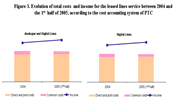
(Click here to see the full-size image)
Figure 4 and Figure 5 display the margins for the leased line service, according to data of the cost accounting system of PTC for 2004 and the 1st half of 2005, taking into account PTC's price proposal.
Figure 4. Margins of the leased line service, per type of line,
according to the cost accounting system
of PTC for 2004 and the 1st half of 2005
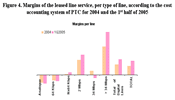
(Click here to see the full-size image)
Figure 5. Margins of the leased line service, per type of line,
according to PTC's proposal and taking into account the cost
accounting system of PTC for 2004 and the 1st half of 2005
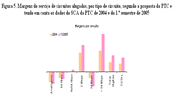
(Click here to see the full-size image)
Having regard to the above-mentioned margins, ICP-ANACOM concludes that the proposal put forward by PTC is not cost-orientated, infringing the principle established in the price control obligation which PTC is bound to comply with, and which was imposed in the assessment of markets of wholesale terminating and wholesale trunk segments of leased lines 9. In that analysis it was defined that prices of wholesale leased lines offer should be cost-orientated, by application of the method for cost estimation adopted up to the present moment, without prejudice to the monitoring of the evolution of the market and price setting methods, taking due account of the evolution at the level of current European practises.
Having PTC been given the opportunity to propose tariffs compatible with the principle of cost orientation of prices, duly substantiated, and in view of the fact that the proposal submitted does not comply with that principle, taking into account the most recent cost data, ICP-ANACOM must intervene and determine a price adjustment, as provided for in article 75 of Law no. 5/2004.
2.4 Adjustment of prices to costs
As referred above, having received, on 30.12.2005, data on the cost accounting system of PTC, relating to the 1st half of 2005, which are the most recent data, these are the data to be used to define the prices compatible with the principle of cost-orientation of prices, based on the capital cost calculated on the basis of their book value.
Estimates adopted by ICP-ANACOM take regard of costs relating to the 1st half of 2005, no cost estimate being carried out concerning 2006, and income estimates, where applicable, are based on the level of line installation in June 2005 (Table 6 displays the level of line installation per operator in June 2005).
|
|
Analogue |
64 Kbps |
Nx64 |
2 Mbps |
34 Mbps |
155 Mbps |
> 155 |
TOTAL |
|
Azertia |
|
|
|
|
|
|
|
|
|
Belgacom |
||||||||
|
Cable & Wireless |
||||||||
|
Colt |
||||||||
|
Compensa - |
||||||||
|
G9 |
||||||||
|
Eastécnica |
||||||||
|
Global One |
||||||||
|
Fleximédia |
||||||||
|
AR Telecom |
||||||||
|
Netvoice |
||||||||
|
Nortenet |
||||||||
|
Oni |
||||||||
|
Sonaecom |
||||||||
|
Radiomóvel |
||||||||
|
Refer |
||||||||
|
Telemilénio |
||||||||
|
Telepac |
||||||||
|
Telelarm |
||||||||
|
TMN |
||||||||
|
Uunet |
||||||||
|
ViaNet.works |
||||||||
|
Vodafone |
||||||||
|
PT Prime |
||||||||
|
TOTAL |
|
|
|
|
|
|
|
|
[ECI]
Figure 6 presents the distribution of lines per type of line (analogue and digital), broken down according to whether they concern the companies of the PT Group or OSP.
Figure 6. Distribution of lines per type of line (analogue and digital)
and per companies concerned (PT Group and OSP)
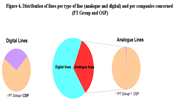
(Click here to see the full-size image)
As regards analogue lines, as PTC’s margin for the monthly payment of these lines is negative, according to the data of the cost accounting system for 2004, based on capital cost calculated on the basis of their book value, ICP-ANACOM does not oppose to the alterations proposed by PTC as regards the prices of analogue lines. Moreover, in the first nine months of 2005, only two analogue lines were installed by companies other than those of the PT Group, which evidences the low demand of this type of lines.
It has also been verified, by analysis of figures above presented (namely Figure 1) that the level of installation of analogue lines has been decreasing since 2001.
As far as digital lines are concerned, and taking into account that cost accounting data submitted by PTC are not broken down by types of N×64 Kbps lines, and that the proposal submitted by PTC presents estimates of such margins based on cost data for 2004, the first approach is based on margins presented by PTC calculated on the basis of costs for 2004 to infer the possibility of adjusting prices of the various types of N×64 Kbps lines. Bearing in mind this first approach, the costs of the 1st half of 2005 are used to assess the global margins resulting from adjustments performed. Thus, Table 7 presents net margins resulting from the price proposal of PTC, by reference to the cost accounting data for 2004.
|
Speeds |
LE |
Main Line |
||
|
<10Km |
Between 10 |
Between 30 |
||
|
64 Kbps |
|
|
|
|
|
2 Mbps |
|
|
|
|
|
TOTAL |
||||
|
Speeds |
Main Line |
CAM |
TOTAL |
||
|
Between 50 and 100 Km |
>100Km |
Routes |
|||
|
64 Kbps |
|
|
|
|
|
|
2 Mbps |
|
|
|
|
|
|
TOTAL |
|
|
|
|
|
[ECI]
This means that, especially as regards lines with capacity between 256 Kbps and 1536 Kbps, PTC shows significant margins, both for local extensions and main lines, for all lengths. Likewise, in 2 Mbps and 155 Mbps lines, PTC earns margins which are not compatible with the principle of cost-orientation of prices. Figure 7 presents the margin, per type of line, based on data of the cost accounting system for 2004, based on capital valuation according to its book value, based on the level of installation in June 2005.
Figure 7. Margins of the leased lines service, according to the proposal
submitted by PTC, per type of line
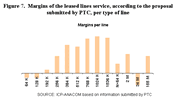
(Click here to see the full-size image)
Analysing the weight of each type of line in the total net revenues received by PTC in the 2nd quarter of 2005, it must be concluded that the 2 Mbps lines are the ones which have contributed the most towards such revenues, with a special focus on the main lines component, no routes included (see Table 8).
|
Speeds |
Local Extensions |
Main Lines |
Routes |
CAM |
TOTAL |
|
Analogue |
|
|
|||
|
TOTAL |
|
|
|||
[ECI]
Having regard to the information above, and particularly margins in Table 7, ICP-ANACOM deems that prices presented by PTC for digital lines with capacity between 256 Kbps and 2 Mbps and for 155 Mbps lines must be adjusted, in order to render them compatible with the principle of cost orientation.
In the light of the assessment carried out, and taking into consideration cost data for the 1st half of 2005, ICP-ANACOM deems that the prices of the leased line service for digital lines with capacity:
(a) between 256 Kbps (inclusive) and 2 Mbps (inclusive) must be reduced by 15% compared to the reduction proposed by PTC;
(b) of 155 Mbps must be reduced by 20% compared to the reduction proposed by PTC, such reductions being applied equally to each of the above-mentioned capacities and to the different length classes (safeguarding possible inconsistencies which may result from the tariff).
Thus, taking into account the level of installations in June 2005, the global income reduction for the leased lines service would be in the range of 18% compared to the present billing.
The next table displays impact estimates for the reduction of prices proposed by PTC, and the one hereby presented, per operator. These estimates were achieved by applying tariffs to the level of installation of each operator, having regard to the quantity of lines and lengths thereof. Income earned by PTC with installations, alterations or adjustments were not considered, and discounts taking into account estimated billing was applied. It should be noted that, according to PTC, some of the lines engaged by TMN and Vodafone were leased under a different solution on capacity transport. Nevertheless, all lines belonging to these operators were considered for the purpose of the present analysis. It should be noted that global results are not altered where lines of those operators are not considered. Figure 8 presents the same information in graphic format.
|
Operadors |
Current prices |
|||
|
Gross billing |
PP Net billing |
Billing discount |
Net billing |
|
|
Azertia |
|
|
|
|
|
TOTAL OPS |
|
|
|
|
|
TMN |
|
|
|
|
|
Grupo PT |
|
|
|
|
|
TOTAL |
|
|
|
|
|
Operadors |
PTC proposal |
ICP-ANACOM reduction |
Annual savings |
||
|
PP Net billing |
Change |
PP Net billing |
Change |
||
|
Azertia |
|
|
|
|
|
|
TOTAL OPS |
|
|
|
|
|
|
TMN |
|
|
|
|
|
|
TOTAL |
|
|
|
|
|
Figures in thousands of Euros [ECI]
Figure 8. Change in net billing resulting from the
reduction established by ICP-ANACOM [SCI]
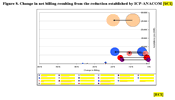
(Click here to see the full-size image)
[ECI]
Taking into account the cost accounting data of PTC for the 1st half of 2005, and considering costs in full, including curtailment costs, and having regard to the proposed reduction of net income by 18%, PTC's margin would be [SCI] [ECI] and [SCI] [ECI], respectively for the global line business and for digital lines. Installation included, PTC's margins would be of [SCI] [ECI] and [SCI] [ECI], respectively for the global line business and for digital lines (see Table 10 and Figure 9).
|
Cost Accounting System |
Monthly payment |
||
|
Analogue |
64 Kbps |
N x 64 Kbps |
|
|
Net Income |
|
|
|
|
Cost Accounting System |
Monthly payment |
||
|
2 Mbps |
34 Mbps |
> 34 Mbps |
|
|
Net Income |
|
|
|
|
Cost Accounting System |
Monthly payment |
Monthly payment and installation |
||
|
Total Digital |
Total |
Total Digital |
Total |
|
|
Net Income |
|
|
|
|
Figures in thousands of Euros [ECI]
Figure 9. Margins of the leased lines service, per type of circuit,
based on cost accounting data for the 1st half of 2005 and price
reduction established by ICP-ANACOM
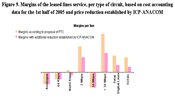
(Click here to see the full-size image)
In terms of comparisons with current practises in the European Union, it is acknowledged that prices for digital lines and for the various lengths are generally below the average of the European Union (considering EU15 countries). Without prejudice, it should be referred that, in several Member States the leased lines service comprise different types of discounts, which are not taken into account in the comparisons below.
The next charts present changes in prices practised in May 2005 in several Member States relatively to the European Union average, considering a length basket for the various Member States 10. In this case, changes compared to the third country with the lowest price are in the range of 7% and 5%, respectively for 64 Kbps and 2 Mbps.
Figure 10. Price comparison at the level of the European Union (EU15)
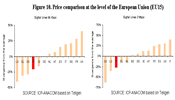
(Click here to see the full-size image)
The data comprised in the Commission Recommendation on the provision of leased lines in the European Union, Part 2, on pricing aspects of wholesale leased line part circuits, of 29 March 2005 11 should also be considered.
Figure 11. Prices of 64 Kbps digital lines at the
level of the European Union (EU15)
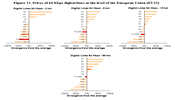
(Click here to see the full-size image)
According to the preceding figure, and to prices that result from this draft decision, prices of 64 Kbps lines are at all times below the EU15 average, for lengths up to 50 Km. However, the higher the length, the more deteriorated is the position of Portugal in comparative terms.
Figure 12. Prices of 2 Mbps digital lines at the
level of the European Union (EU15)
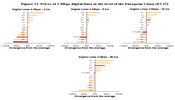
(Click here to see the full-size image)
As far as 2 Mbps lines are concerned, the conclusions reached for 64 Kbps lines are maintained.
Figure 13. Prices of 34 Mbps digital lines at the
level of the European Union (EU15)
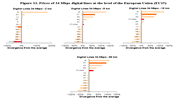
(Click here to see the full-size image)
As regards 34 Mbps lines, conclusions differ from the above. While Portugal presents the lowest price for lengths up to 2 Km, for 50 Km lengths, the price is higher than the EU15 average. In the case of 155 Mbps lines, Portugal presents divergences above the average from 5 km lengths onwards, as the next charts display.
Figure 14. Prices of 155 Mbps digital lines at the
level of the European Union (EU15)
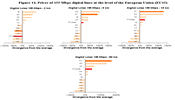
(Click here to see the full-size image)
The Table 11 presents a summary of the charts above:
|
64 Kbps |
2 Mbps |
||||||
|
2km |
5km |
15km |
50km |
2km |
5km |
15km |
50km |
|
2nd |
5th |
4th |
6th |
1st |
3rd |
5th |
8th |
|
-46% |
-19% |
-17% |
-8% |
-63% |
-27% |
-17% |
-3% |
|
34 Mbps |
155 Mbps |
||||||
|
2km |
5km |
15km |
50km |
2km |
5km |
15km |
50km |
|
1st |
8th |
10th |
9th |
3rd |
8th |
9th |
9th |
|
-52% |
6% |
16% |
24% |
-47% |
15% |
29% |
44% |
It should be noted that the variation of prices practised in Portugal worsen as (a) lengths and (b) speeds increase.
It is highlighted that (a) around 88% of lines leased by OSP to PTC are below 30 km and that (b) more than 98% of OSP billing for the leased lines service result from the engagement of speed lines up to 2 Mbps, inclusive.
As regards annual prices applicable to the international component of access to the backhaul service, without security, it is verified that such prices are close to the price of a main line with the same capacity for lengths under consideration (Picoas-Sesimbra and Picoas-Carcavelos). Table 12 and Table 13 present the divergence between the price of the international component of access to the backhaul service and the price of a main line with the same length (positive values indicate that the price of the international component of access to the backhaul service is higher than the price of a main line with the same length).
|
Connection |
Length |
International Component of |
International Component of |
||||
|
2M |
34M |
155M |
2M |
34M |
155M |
||
|
Picoas - Sesimbra |
32 |
8% |
1% |
5% |
25% |
19% |
22% |
|
Picoas - Carcavelos |
17 |
25% |
17% |
22% |
38% |
32% |
36% |
|
Connection |
Length |
International Component of |
International Component of |
||||
|
2M |
34M |
155M |
2M |
34M |
155M |
||
|
Picoas - Sesimbra |
32 |
2% |
-20% |
-16% |
20% |
-7% |
-2% |
|
Picoas - Carcavelos |
17 |
18% |
-7% |
-3% |
33% |
10% |
14% |
It is considered that in terms of tariff presentation, prices applicable to the international component of access to the backhaul service should be indexed to the price of a main line.
As regards the maintenance of the fidelity reward, it should be referred that, at least in Belgium, France, Germany, Italy, Spain and the United Kingdom, such rewards exist, with a period of duration between 3 and 5 years 12, with values similar to those proposed by PTC. In these terms, the existence of Community practises in this matter lead ICP-ANACOM not to set aside the maintenance of a fidelity reward.
There is also a set of prices, applied namely to interior and exterior changes, to speed alterations, to other alterations and to other services and facilities, for which PTC has not presented any grounds. In these terms, it is requested that such grounds are submitted with a 20-day deadline.
Lastly, as regards the application of the "retail-minus" rule, which aims at avoiding situation of crushed margins on the part of companies of the PT Group, PT Prime applied a difference by 26% between wholesale prices and retail prices at the level of each transmission capacity, considering for each speed, a weighted average of lengths according to the level of installations.
The next table presents PT Prime' margin estimates for each capacity and for the several lengths, and it should be concluded that the "retail-minus" rule is complied with, save for individual cases.
|
Speeds |
Local Extension |
Main Line |
||||||
|
2,5 Km |
5 Km |
7,5 Km |
10 Km |
20 Km |
30 Km |
45 Km |
||
|
64 Kbps |
|
|
|
|
|
|
|
|
|
128 Kbps |
|
|
|
|
|
|
|
|
|
192 Kbps |
|
|
|
|
|
|
|
|
|
256 Kbps |
|
|
|
|
|
|
|
|
|
384 Kbps |
|
|
|
|
|
|
|
|
|
512 Kbps |
|
|
|
|
|
|
|
|
|
768 Kbps |
|
|
|
|
|
|
|
|
|
1024 Kbps |
|
|
|
|
|
|
|
|
|
1536 Kbps |
|
|
|
|
|
|
|
|
|
2 Mbps |
|
|
|
|
|
|
|
|
|
Speeds |
Main Line |
CAM |
|||||
|
60 Km |
92,5 Km |
125 Km |
150 Km |
200 Km Route |
300 Km Route |
||
|
64 Kbps |
|
|
|
|
|
|
|
|
128 Kbps |
|
|
|
|
|
|
|
|
192 Kbps |
|
|
|
|
|
|
|
|
256 Kbps |
|
|
|
|
|
|
|
|
384 Kbps |
|
|
|
|
|
|
|
|
512 Kbps |
|
|
|
|
|
|
|
|
768 Kbps |
|
|
|
|
|
|
|
|
1024 Kbps |
|
|
|
|
|
|
|
|
1536 Kbps |
|
|
|
|
|
|
|
|
2 Mbps |
|
|
|
|
|
|
|
[ECI]
In this context, the tariff submitted by PT Prime is deemed to be compatible with the "retail-minus" rule.
3. Quality of service
According to the LLRO proposal submitted by PTC, the quality of service parameters concerning the supply time for network line installation, repair time for faults and degree of availability are defined taking into consideration the types of contract currently concluded, broken down by three categories:
(a) Base contract;
(b) Line Network;
(c) Large line network.
The offer does not describe the conditions attached to each of the contracts under consideration. Thus ICP-ANACOM considers that, first and foremost, having regard to the principles of non-discrimination and transparency which PTC is bound to comply with, under the assessment of wholesale terminating and wholesale trunk segments of leased lines, the offer must present the characteristics attached to each of the referred types of contract.
In order to analyse the quality of service proposed by PTC, ICP-ANACOM requested of that company data on the supply time for network line installation, repair time for faults and degree of availability verified between 2002 and the 1st half of 2005.
3.1. Supply time for network line installation
PTC proposes to define the following targets relative to the supply time for network line installation:
|
Tpe of contract |
Services |
Target |
Incidence |
|
|
Base contract, line network and large line network |
Leased lines (end-to-end and part circuits) |
<155Mbps |
45 days |
100% |
|
155Mbps |
case by case |
100% |
||
|
Lines for traffic interconnection |
45 days |
100% |
||
|
Lines for sub-sea cables access |
45 days |
100% |
||
ICP-ANACOM verifies that the offer is not clear as whether the indicator concerns the average supply time or the maximum supply time for a 100% of cases on a monthly basis, per OSP. Having regard to data submitted by PTC relatively to time limits practised for line installation, it is considered that this indicator concerns the average supply time for a 100% of cases.
According to the Commission Recommendation of 21.01.2005 13, supported on data for 2002, the maximum time limits for 95% of cases should be as follows:
(a) 18 calendar days for 64 Kbps leased lines;
(b) 30 calendar days for 2 Mbps unstructured leased lines ;
(c) 33 calendar days for 2 Mbps structured leased lines;
(d) 52 calendar days for 34 Mbps unstructured leased lines.
According to data concerning that recommendation PTC complied, in 2002, with the time limits displayed above, except for 2 Mbps unstructured leased lines, for which PTC practised 5 calendar days in excess of the recommended time limit.
Since that date, the maximum time limits for 95% of cases practised by PTC have significantly declined, between 50% and 200%, improving only, by 27%, as regards 155 Mbps lines (see Figure 15). Figure 15 presents also values stated in the Commission Recommendation of 21.01.2005, the third lowest value and the EU15 average observed for 2003 14.
Figure 15. Time limits to supply digital lines
(maximum time limits for 95% of cases)
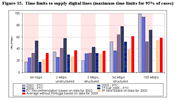
(Click here to see the full-size image)
The decline in supply time for network line installation is not supported by an increase of demand, as Figure 16 may demonstrate.
As a result, for example, there is a decrease in the number of 64 Kbps lines installed between 2002 and 2004, and an increase of the supply time for network line installation, or an increase of the number of 155 Mbps lines and a reduction of the respective supply time for network line installation.
Figure 16. Evolution of the number of digital line installation
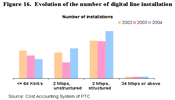
(Click here to see the full-size image)
As referred above, the level of installation of digital leased lines of PTC has remained relatively constant over the years, and the number of installations does not present a degree of divergence that justifies a sustained decline in the supply time for network line installation. In particular, there is no justification for a quality of service below the EU average, in fact a quality above the average is desired, as was the case for PTC in 2002. In this respect, it is important to take into consideration the commitment between prices and the quality of service.
Thus, in a context of a gradual evolution, it is deemed excessive to set a supply time for network line installation according to the third lowest value, and or this reason, time limits should be based on the maximum time limits for 95% of cases in EU15 average, based on the last available data, as follows:
(a) 33 calendar days for 64 Kbps leased lines;
(b) 37 calendar days for 2 Mbps unstructured leased lines ;
(c) 37 calendar days for 2 Mbps structured leased lines;
(d) 62 calendar days for 34 Mbps unstructured leased lines;
(e) 59 calendar days for 155 Mbps leased lines.
It should be noted that, nonetheless, except for the supply time for network line installation concerning the 64 Kbps leased lines, the remaining time limits present divergences from the best practises below 25%. Moreover, it should also be noted that during the first nine months of 2005, 95% of lines installed for OSP refer to N×64 Kbps and 2 Mbps leased lines.
It should be highlighted that Oni and Sonaecom proposed supply times for network line installation in line with those of the third country with the lowest time limit, Apritel having proposed time limits below 30 days (not specifying whether this is an average or maximum time limit).
3.2. Repair time for faults
The LLRO proposal defines the following targets for the repair time for faults:
|
Type of contract |
Services |
Target |
Incidence |
|
|
Base contract |
Leased lines (end-to-end and part circuits) |
6 hours |
80% |
|
|
Lines for traffic interconnection |
Interconnection lines |
6 hours |
80% |
|
|
Internal extensions for interconnection |
4 hours |
80% |
||
|
Line network |
Leased lines (end-to-end and part circuits) |
< 155 Mbps |
6 hours |
80% |
|
155 Mbps |
4 hours |
90% |
||
|
Lines for traffic interconnection |
Interconnection lines |
6 hours |
80% |
|
|
Internal extensions for interconnection |
4 hours |
80% |
||
|
Large line network |
Leased lines (end-to-end and part circuits) |
< 155 Mbps |
4 hours |
90% |
|
24 hours |
98% |
|||
|
155 Mbps |
4 hours |
80% |
||
|
Lines for traffic interconnection |
4 hours |
90% |
||
|
12 hours |
98% |
|||
As is the case for the supply time for network line installation, the offer does not define clearly whether the indicator concerns the maximum repair time for faults or the average repair time for faults. Having regard to values practised by PTC, it is considered that this indicator concerns the maximum repair time for faults for the rate of cases submitted.
Figure 17 presents the evolution of the maximum repair time for faults for 80% of cases, practised by PTC, as well as the third lowest value and the EU15 average based on values for 2003 15. From the assessment of Figure 17 it may be concluded that the repair time for faults proposed by PTC, which vary according to the type of contract and of service, are reasonable when compared to the time limit already practised, with the EU15 average and the third lowest value. Therefore, having regard to available information, there is no reason for an alteration thereof.
Figure 17. Leased lines repair time
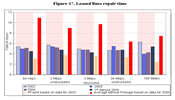
(Click here to see the full-size image)
It is deemed necessary that PTC includes an appropriate time limit for fault repair applicable to lines for sub-sea cables access, as for this type of service no repair time for faults is mentioned.
It is highlighted that Apritel proposed a two-hour repair time for faults, a value which is significantly below both the EU15 average and the third country with the lowest time limit.
3.3 Degree of availability
As far as the degree of availability is concerned, PTC has defined the following indicators:
|
Type of contract |
Services |
Target |
|
|
Base contract |
Leased lines (end-to-end and part circuits) |
99,00% |
|
|
Lines for traffic interconnection |
99,90% |
||
|
Lines for sub-sea cables access |
Without security |
99,50% |
|
|
With security |
99,90% |
||
|
Line network |
Leased lines (end-to-end and part circuits) |
< 155 Mbps |
99,50% |
|
155 Mbps |
99,99% |
||
|
Lines for traffic interconnection |
99,90% |
||
|
Lines for sub-sea cables access |
Without security |
99,50% |
|
|
With security |
99,90% |
||
|
Large line network |
Leased lines (end-to-end and part circuits) |
< 155 Mbps |
99,85% |
|
155 Mbps |
99,99% |
||
|
Lines for traffic interconnection |
99,90% |
||
|
Lines for sub-sea cables access |
Without security |
99,50% |
|
|
With security |
99,90% |
||
According to information made available by PTC, that company ensured, in the 1st quarter of 2005, an average degree of availability not below 99,96%, a value which had been defined in the Determination of ICP-ANACOM dated 31.07.2002, relative to levels of quality for the leased lines service.
This Authority deems that, in this case, there are no grounds to decrease targets of quality of service currently in force. In this context, it is considered that PTC must alter targets of service availability which are below 99,96% to a similar minimum value.
Also in the scope of the degree of availability Apritel proposed more demanding levels than those proposed by PTC.
3.4 Penalties for non-compliance
PTC undertakes to apply compensation for failure to comply with performance targets defined for the supply time for network line installation, repair time for faults and degree of availability.
Relatively to compensation for failure to comply with supply time for network line installation, PTC proposes the following:
|
Type of contract |
Services |
Compensation |
|
Base contract, line network, large line network |
Leased lines (end-to-end and part circuits) |
D/30xPMC |
|
Lines for traffic interconnection (interconnection lines and Internal extensions for interconnection) |
D/30xPMC |
In this regard, it should be stated that Novis and Oni showed some concerns on the supply times practised by PTC, referring significant delays in the provision of lines, even in situation where requests are submitted within a reasonable time period prior to a target date. These delays may harm the leased lines offer on the part of alterative operators to the PTC Group, especially where significant contracts with business customers are at stake.
Thus, it is considered that this proposal of PTC does not provide an adequate incentive for that company to supply lines within the defined time limit.
It must be taken into consideration that, in the scope of the determination on product markets and geographic markets, the assessment of significant market power (SMP) and the imposition, maintenance, amendment or withdrawal of regulatory obligations relative to markets 7 16, 13 17 e 14 18, Oni submitted the following proposal 19 regarding compensation for non-compliance with supply time for network line installation:
|
Days behind Schedule compared to supply date |
Compensation (x% rate on monthly payment value) |
|
1 – 5 |
25% |
|
6 – 10 |
50% |
|
11 – 15 |
100% |
Furthermore, according to the proposal of Oni, in case the delay is equal to or more than 15 days, to the compensation referred in the table for the 100% level should be added 7% of the monthly payment of the line under consideration per each additional day.
In graphic terms, the proposals of PTC and Oni are as follows:
Figure 18. Proposal of Oni v.s. proposal of PTC
for compensation for non-compliance
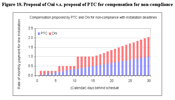
(Click here to see the full-size image)
The proposal submitted by Oni which, overall, doubles the value proposed by PTC, is more demanding than the proposal of PTC, yet is not disproportionate, being deemed reasonable and appropriate for the purposes intended.
Relatively to compensation for non-compliance with repair time for faults and degree of availability, ICP-ANACOM, in the light of available information, namely absence of concrete claims against systemic non-compliance in this matter, deems there are no reasons to alter compensation proposed by PTC for non-compliance with these targets, without prejudice to the need to adjust values on compensation for unavailability, resulting from the fact that an average degree of availability equal to or above 99.96% has been established.
ICP-ANACOM will monitor market evolution and, if this compensation is not deemed appropriate, in case possible damage is caused or in case it is considered that compensation is not dissuasive, this Authority shall intervene in order to ensure the existence of competitive conditions and to promote the protection of users.
Lastly, it should be noted that compensation for non-compliance with supply time for network installation and repair time for faults as regards sub-sea cables access has not been provided for, a situation which must be altered.
III. Determination
Having regard to the assessment above, the Board of Directors of ICP-ANACOM, in the scope of assignments provided for in points b), e) and f) of article 6 of the Statutes, approved by Decree-Law no. 309/2001, of 7 December, and under point a) of paragraph 3 of article 68 of Law no. 5/2004 and points b) and g) of article 9 of the Statutes, determines to submit he following determination to the prior hearing of interested parties, pursuant to articles 100 and 101 of the Code of Administrative Procedure, establishing a 10-woring-day time limit, so that interested parties, if they so desire, may express their opinion, in writing, on the following:
1. PT Comunicações must alter the leased lines reference offer and publish it, within a 15-day period, taking into account the principles of non-discrimination and cost-orientation, and especially, the following:
(a) Prices of digital lines with capacity between 256 Kbps (inclusive) and 2 Mbps (inclusive) must be reduced by 15% compared to the reduction proposed by PTC on 19.10.2005;
(b) Prices of 155 Mbps digital lines must be reduced by 20% compared to the reduction proposed by PTC on 19.10.2005;
(c) Prices applicable to the international component of access to the backhaul service without security should be indexed to the price of a main line.
(d) Supply time for network line installation should be altered, the following maximum time limits being set for 95% of cases:
- 33 calendar days for 64 Kbps leased lines;
- 37 calendar days for 2 Mbps unstructured leased lines;
- 37 calendar days for 2 Mbps structured leased lines;
- 62 calendar days for 34 Mbps unstructured leased lines;
- 59 calendar days for 155 Mbps leased lines.
(e) An adequate time limit must be introduced as regards the fault repair time applicable to lines for sub-sea cables access.
(f) The compensation due for fault repair time must be extended to base contracts.
(g) Minimum targets for service availability must be altered to 99.96%.
(h) The following compensation for failure to comply with supply time for network line installation must be defined:
- 25% of the value of monthly payment for the line under consideration where the service is provided between one to five days behind schedule compared to supply date;
- 50% of the value of monthly payment for the line under consideration where the service is provided between six to behind schedule;
- 100% of the value of monthly payment for the line under consideration where the service is provided between eleven to fifteen days behind schedule compared to supply date;
- additional 7% of the value of monthly payment, applied on the amount referred in the preceding point, for the line under consideration per each additional day of delay in excess of fifteen days.
(i) Compensation for non-compliance with supply time for network installation and repair time for faults as regards sub-sea cables access must be provided for.
(j) Any provision that restricts the supply of leased lines on account of their purpose must be withdrawn from the offer, or it should be clarified that PT Comunicações may not refuse any reasonable request for leased lines supply, namely in order to enable OSP to provide leased lines services to other OSP.
(k) Target dates must not exceed supply time for network line installation.
(l) It must be clarified that the supply of a part circuit only implies necessarily the supply of a local extension and of an internal extension by PTC Comunicações to the OSP, the supply of a main line being optional.
(m) The features of coaxial distribution frames or of terminal equipment which OSP are entitled to use must be clearly defined in the offer, a reasonable and appropriate time limit, of up to 10 days, being set, to enable PT Comunicações to assess the possibility of installation of equipment with different features from those provided in the offer. In case a negative reply is given to the request made by the OSP, PTC must present adequate justification thereto.
(n) PTC must suppress the maximum 30-day negotiation time limit calculated from the date the OSP receives the contractual form to conclude a contract, following which, in case an agreement is not reached between the parties, PTC reserves the right to suspend the provision of services comprised in the LLRO.
(o) The minimum retention time of 6 months (without security), or of 12 months (with security) as regards lines with 155 Mbps capacity, must be suppressed.
(p) Lines for the sub-sea cables access must not be billed on an annual basis, rather at a monthly frequency.
(q) The performance of control operations, adjustments or routine maintenance procedures should be carried out, whenever possible, on a date previously agreed between PT Comunicações and the OSP, and, whenever possible, PTC must guarantee alternatives, namely temporary security procedures, thus enabling a minimum service interruption.
(r) The minimum time limit for the definition of a target date calculated from the date of request, in case of lines that connect to a new OSP knot or the supply of which implies the installation of fibre optic in the local extension must be reduced to an appropriate level compared to remaining situations provided in the offer.
(s) In the event of a line installation, following the elapse of the target date, where a pending situation occurs on account of the customer for a 30-day period, consecutive or not, the billing shall start on the target date; thus, the line request shall not be cancelled, nor the OSP shall be subject to the payment of an amount which represents twice the value of the line’s monthly subscription price, plus the price of installation thereof.
(t) In case the OPS cancels the installation of a line in a pending situation on account of the customer for a 30-day period, consecutive or not, following the elapse of the target date, the billing shall start on the target date. The OSP is liable to a payment that corresponds to the period between the target date and the disconnection date, however is not subject to the payment of a compensation of an amount which represents twice the value of the line’s monthly subscription price, plus the price of installation thereof.
(u) In the scope of the negotiation of special supply conditions, namely the introduction of specific security means at the level of the respective local extensions, it shall be made clear that the adopted technical and commercial conditions shall be proportional and coherent in relation to all cases of supply, thus in similar situations, identical conditions shall be applied.
(v) The 60-day time limit to provide the notice of termination of a contract for lines for the sub-sea cables access must be reduced and minimum periods of duration for leased lines contracts shall be suppressed.
(w) In the absence of duly substantiated grounds, PTC must suppress the requirement for documentary evidence (LOA), whereby the capacity owner authorizes the connection thereof to the backhaul requested by the OSP, in case the latter is not the owner of the capacity of the sub-sea system.
(x) The offer must provide for the possibility, in operational control meetings, to debate pending situations on account of PTC. For this purpose, this company shall submit to the OSP, three days prior to the date of the meeting, a list of pending situations, describing causes thereto and the period of time deemed necessary to restore such situations.
(y) In case PTC identifies a fault on its own initiative, it shall launch all procedures necessary to restore the situation, proactively reporting the fault to the OSP.
(z) Any contacts made to the end-customer of the OSP, in case access to his/her premises is necessary to repair a fault, must be established by the OSP itself, and for this purpose, PTC shall undertake to make all necessary approaches to the OSP.
(aa) PT Comunicações shall include in the offer alteration prices and other services and facilities, namely prices applicable to interior and exterior changes and speed alterations, submitting to ICP-ANACOM detailed reasons thereto.
1 See, for example, Annex 5, pg. 6, ''in case of an internal extension for traffic interconnection supplied by a third co-installed OSP, it falls upon the OSP owner of the traffic to ensure that the co-installed OSP has previously requested the necessary means from PT Comunicações.''
2 See Prices for leased lines interconnection services and for interconnection componentshttps://www.anacom.pt/render.jsp?contentId=421077.
3 Network Termination Point.
4 Main Line.
5 Local Extension.
6 According to PTC, the price proposal for CAM lines results in a reduction by 39% of average net prices of these lines as a whole, both analogue and digital.
7 As regards the method to be used for capital cost valuation, ICP-ANACOM has already notified PTC that it deems the method for capital cost valuation based on values of privatization stages not to be appropriate, as: (i) this method may not be repeated in subsequent years, which renders impracticable a comparison of results achieved; (ii) the use of share prices to determine amounts invested by shareholders could lead to speculative or exogenous effects; and (iii) it could promote the establishment of an effect where the share would determine the company's results.
8 This was roughly the case for 2004.
9 See Leased line markets (markets 7, 13 and 14)https://www.anacom.pt/render.jsp?contentId=419296.
10 The Teligen method and basket are used for this purpose (without Purchasing Power Parities). Prices for Portugal include the proposed additional reduction.
11 Available at European Union Law - Electronic communicationshttps://www.anacom.pt/render.jsp?categoryId=333822.
12 Source: Tarifica pricer, November 2005.
13 Recommendation C(2005)103/1 finalhttps://www.anacom.pt/render.jsp?categoryId=333822.
14 According to the document COCOM04-72 FINAL ''2003 report on performance in the supply of leased lines pursuant to Directive 92/44/EC''.
15 According to the document COCOM04-72 FINAL "2003 report on performance in the supply of leased lines pursuant to Directive 92/44/EC".
16 Retail leased lines market.
17 Wholesale terminating segments of leased lines.
18 Wholesale trunk segments of leased lines.
19




